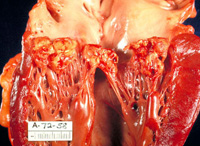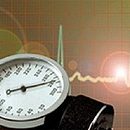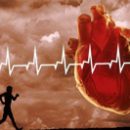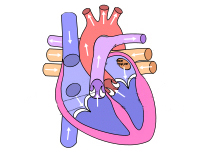Infective endocarditis manifests itself by damage to the inner shell of the endocardium, and both separate chambers and valves. In the end of the disease develops valve insufficiency. Lack of proper treatment can lead to patient death.
Content
Causes of infectious endocarditis
 Infectious (bacterial, septic) endocarditis - a disease consisting in infectious damage to the inner shell (endocardium) of both individual chambers and heart valves, often with the development of valve deficiency. In the absence of treatment of infectious endocarditis can lead to the death of the patient. Infectious endocarditis folds from several principled moments. First, a number of people have congenital or acquired (more often rheumatic) flavors of the heart valves (secondary infectious endocarditis). These vices contribute to the change in the intraconductural circulation of blood, resulting in constant injury to the endocardium of any heart valve. In some cases, such injuries may occur and spontaneously (primary infectious endocarditis). At the site of traumatic damage to the fabric, special substances be separated, contributing to the healing of damage. In this case, to the place of traumatic damage «glued» Various blood cells (platelets and others.), forming cellular growths (vegetation), resembling icicles hanging from the valve. If at this time any infection will fall into the vascular channel (blood flow), there is a risk that it will be introduced into these vegetation. Infection may fall into the bloodstream due to various dental (tooth removal), gynecological (scraping of the uterine) procedures, as well as due to suppuration of the skin and T.D.
Infectious (bacterial, septic) endocarditis - a disease consisting in infectious damage to the inner shell (endocardium) of both individual chambers and heart valves, often with the development of valve deficiency. In the absence of treatment of infectious endocarditis can lead to the death of the patient. Infectious endocarditis folds from several principled moments. First, a number of people have congenital or acquired (more often rheumatic) flavors of the heart valves (secondary infectious endocarditis). These vices contribute to the change in the intraconductural circulation of blood, resulting in constant injury to the endocardium of any heart valve. In some cases, such injuries may occur and spontaneously (primary infectious endocarditis). At the site of traumatic damage to the fabric, special substances be separated, contributing to the healing of damage. In this case, to the place of traumatic damage «glued» Various blood cells (platelets and others.), forming cellular growths (vegetation), resembling icicles hanging from the valve. If at this time any infection will fall into the vascular channel (blood flow), there is a risk that it will be introduced into these vegetation. Infection may fall into the bloodstream due to various dental (tooth removal), gynecological (scraping of the uterine) procedures, as well as due to suppuration of the skin and T.D.
Intended infection initially causes a narrowing of the valve opening, and then promotes the damage to the valve. Similar picture more typical for infectoon endocarditis of left heart chambers. In case of infectious endocarditis of right chambers of the heart, the infection is introduced into the bloodstream through damaged veins, for example, in persons who use intravenously drugs, as well as in patients with long-lasting vanish vascular catheters. In addition, these catheters can directly injury endocardium right heart departments. Further development of infectious endocarditis largely depends on the pathogenicity of the microbial agent, t.E. From his ability to cause a disease, as well as from the immunity of the body of the patient to infection, t.E. Immunity.
The main manifestations of the disease
Depending on the limitation time of the disease distinguishes acute (8-10 weeks) and subacute (more than 10 weeks) valve infectious endocarditis. Most often infectious endocarditis causes so-called golden and epidermal (skin) staphylococci, less often - enterococci, green streptococcus and other microorganisms. Infectious endocarditis caused by fungal microflora. It is usually observed in patients, previously long and unsuccessfully received various antibiotics. Depending on the causative agent of infection infectious endocarditis, it can develop suddenly and rapidly (golden staphylococcus, enterococci) or urgent (green streptococcus). The beginning of the disease is manifested by high temperatures with stunning chills and severe sweating. The disease can imitate many other infectious diseases. At this stage, the disease is rarely recognized, and antibiotics are usually prescribed to the patient, and the occurrence of the disease may disappear for some time. At the same time, vegetation with microbes contained inside them can be covered outside the original protective film, the infection from the active turns into «Dormant». After time, the microbes are breaking the protective film and come into the bloodstream again, which is accompanied by the above-described manifestations of the disease (high temperature and t.D.).
For a subacute valve infectious endocarditis are characterized by general ailment, moderate body temperature increase, fast fatigue, weight loss. The course of this variety of valve infectious endocarditis can last for months and even years. In the event that a heart disease is formed as a result of a valve infectious endocarid, there may be signs of heart failure among the manifestations of the disease (shortness of breath, edema of the legs, the increase in liver T.D.). Vegetation with valve infectious endocarditis can be of various sizes and mobility. There is always a risk that all the vegetation or part of it can break away from the valve and spread with blood flow (embolism). In case of infectious endocarditis of the left departments of the heart, embolism can lead to heart attacks of various organs (brain, hearts, kidneys, spleen, intestines, etc.D.), as well as to the blockage of large and small arteries. In some cases, the development of infection in a new place becomes possible, for example, with so-called mycotic aneurysms. With infectious endocardits of the right-hand heart departments, the pulmonary artery embolism is possible, often with the development of the so-called infarction pneumonia (inflammation of the lungs).









